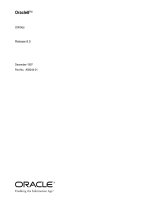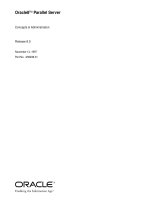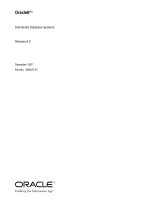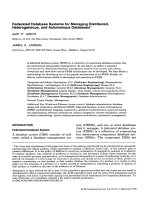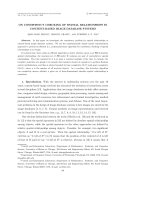Oracle8 Distributed Database Systems Release 8.0 pot
Bạn đang xem bản rút gọn của tài liệu. Xem và tải ngay bản đầy đủ của tài liệu tại đây (810.9 KB, 214 trang )
Oracle8
Distributed Database Systems
Release 8.0
December 1997
Part No. A58247-01
Oracle8 Distributed Database Systems
Part No. A58247-01
Release 8.0
Copyright © 1996, 1997, Oracle Corporation. All rights reserved.
Primary Author: Jason Durbin
Contributing Authors: Steve Bobrowski, Peter Vasterd
Contributors: John Bellemore, Anupam Bhide, Roger Bodamer, Jacco Draaijer, Diana Foch-Laurentz,
Nina Lewis, Raghu Mani, Basab Maulik, Denise Oertel, Paul Raveling, Kendall Scott, Gordon Smith, Katia
Tarkhanov, Sandy Venning, Eric Voss
The programs are not intended for use in any nuclear, aviation, mass transit, medical, or other inher-
ently dangerous applications. It shall be licensee's responsibility to take all appropriate fail-safe, back
up, redundancy and other measures to ensure the safe use of such applications if the Programs are
used for such purposes, and Oracle disclaims liability for any damages caused by such use of the Pro-
grams.
This Program contains proprietary information of Oracle Corporation; it is provided under a license
agreement containing restrictions on use and disclosure and is also protected by copyright patent and
other intellectual property law. Reverse engineering of the software is prohibited.
The information contained in this document is subject to change without notice. If you find any problems
in the documentation, please report them to us in writing. Oracle Corporation does not warrant that this
document is error free.
If this Program is delivered to a U.S. Government Agency of the Department of Defense, then it is deliv-
ered with Restricted Rights and the following legend is applicable:
Restricted Rights Legend Programs delivered subject to the DOD FAR Supplement are 'commercial
computer software' and use, duplication and disclosure of the Programs shall be subject to the licensing
restrictions set forth in the applicable Oracle license agreement. Otherwise, Programs delivered subject to
the Federal Acquisition Regulations are 'restricted computer software' and use, duplication and disclo-
sure of the Programs shall be subject to the restrictions in FAR 52 227-14, Rights in Data General,
including Alternate III (June 1987). Oracle Corporation, 500 Oracle Parkway, Redwood City, CA 94065.
Oracle, Oracle8, SQL*Forms, Net8, and SQL*Plus are registered trademarks of Oracle Corporation, Red-
wood Shores, California.
Oracle Call Interface, Oracle7, Oracle7 Server, Oracle8, Oracle Forms, PL/SQL, Pro*C, Pro*C/C++, and
Enterprise Manager are trademarks of Oracle Corporation, Redwood Shores, California.
Oracle Security Server contains encrytion and/or authentication engines from RSA Data Security, Inc.
Copyright 1996 RSA Data Security, Inc. All Rights reserved. This version supports International Security
with RSA Public Key Cryptography, MD2, MD5, and RC4r.
iii
Contents
How Oracle8 Distributed Database Systems is Organized Preface-xvi
Conventions Used in This Guide Preface-xviii
Your Comments Are Welcome Preface-xix
1 Distributed Database Concepts
Oracle’s Distributed Database Architecture 1-2
Clients and Servers 1-2
The Network 1-4
Databases and Database Links 1-4
Database Links 1-5
Schema Object Name Resolution 1-6
Connecting Between Oracle Server Versions 1-7
Distributed Databases and Distributed Processing 1-7
Distributed Databases and Database Replication 1-7
Heterogeneous Distributed Databases 1-8
Heterogeneous Services 1-8
Heterogeneous Services Agents 1-9
Features 1-9
Developing Distributed Database Applications 1-10
Remote and Distributed SQL Statements 1-10
Remote Procedure Calls (RPCs) 1-11
Remote and Distributed Transactions 1-11
Transparency in a Distributed Database System 1-13
iv
Administering an Oracle Distributed Database System 1-15
Site Autonomy 1-15
Distributed Database Security 1-16
Tools for Administering Oracle Distributed Databases 1-17
Enterprise Manager 1-17
Third-Party Administration Tools 1-18
SNMP Support 1-18
National Language Support 1-19
2 Distributed Database Administration
Global Database Names and Global Object Names 2-2
Types of Database Links 2-3
Private, Public, and Global Database Links 2-3
Security Options for Database Links 2-4
Shared Database Links 2-6
Connection Qualifiers 2-13
Database Link Resolution 2-14
Schema Object Name Resolution 2-15
Views, Synonyms, Procedures and Global Name Resolution 2-17
Dropping a Database Link 2-19
Listing Available Database Links 2-19
Limiting the Number of Active Database Links 2-19
Techniques for Location Transparency 2-20
Views and Location Transparency 2-20
Synonyms and Location Transparency 2-22
Procedures and Location Transparency 2-24
Statement Transparency 2-25
Restrictions 2-26
Values for Environmentally-Dependent SQL Functions 2-26
Shared SQL for Remote and Distributed Statements 2-26
v
3 Distributed Transactions
Distributed Transaction Management 3-2
The Prepare and Commit Phases 3-2
Prepare Phase 3-2
Commit Phase 3-4
The Session Tree 3-5
Clients 3-6
Servers and Database Servers 3-6
Local Coordinators 3-7
The Global Coordinator 3-7
The Commit Point Site 3-8
A Case Study 3-11
The Scenario 3-11
The Process 3-12
Coordination of System Change Numbers 3-18
Read-Only Distributed Transactions 3-18
Limiting the Number of Distributed Transactions Per Node 3-19
Troubleshooting Distributed Transaction Problems 3-20
Failures that Interrupt Two-Phase Commit 3-20
Failures that Prevent Data Access 3-21
Manually Overriding In-Doubt Transactions 3-22
Manual Override Example 3-23
Step 1: Record User Feedback 3-25
Step 2: Query DBA_2PC_PENDING 3-25
Step 3: Query DBA_2PC_NEIGHBORS 3-26
Manually Checking the Status of Pending Transactions at SALES.ACME.COM 3-27
Manually Checking the Status of Pending Transactions at HQ.ACME.COM: 3-29
Step 4: Check for Mixed Outcome 3-29
The Pending Transaction Table (DBA_2PC_PENDING) 3-30
Manually Committing In-Doubt Transactions 3-31
Forcing a Commit or Rollback in Enterprise Manager 3-31
Manually Committing or Rolling Back In-Doubt Transactions 3-32
Changing Connection Hold Time 3-33
Setting a Limit on Distributed Transactions 3-33
vi
Testing Distributed Transaction Recovery Features 3-34
Forcing a Distributed Transaction to Fail 3-34
The Recoverer (RECO) Background Process 3-35
Disabling and Enabling RECO 3-35
4 Using the Oracle Security Server
Oracle Security Server 4-2
Oracle Security Server Operation 4-2
Global Users 4-3
Creating Global Users 4-4
Authenticating Global Users 4-4
Global Roles 4-5
Creating Global Roles 4-5
Granting Privileges to Global Roles 4-6
Assigning Global Roles to Global Users 4-6
Enterprise Roles 4-6
Trusting Other Databases 4-6
Trust Between more than Two Databases 4-7
Administering Trust 4-7
5 Distributed Database System Application Development
Factors Affecting the Distribution of an Application’s Data 5-2
Controlling Connections Established by Database Links 5-2
Referential Integrity in a Distributed System 5-3
Distributed Queries 5-3
Tuning Distributed Queries 5-3
Handling Errors in Remote Procedures 5-4
vii
6 Understanding Oracle Heterogeneous Services
What is Heterogeneous Services? 6-2
Heterogeneous Services Agents 6-2
The Services provided by Heterogeneous Services 6-3
Transaction Service 6-3
SQL Service 6-3
Procedural Service 6-4
Using Heterogeneous Services 6-4
Heterogeneous Services Process Architecture 6-5
Process Architecture for Distributed External Procedures 6-6
7 Administering Oracle Heterogeneous Services
Setting up access to Non-Oracle Systems 7-2
Install the Heterogeneous Services Data Dictionary 7-2
Set Up Environment to Access Heterogeneous Services Agents 7-2
Create the Database Link to the Non-Oracle System 7-4
Test the Connection 7-4
Register Distributed External Procedures (Optional) 7-5
Structure of the Heterogeneous Services Data Dictionary 7-5
The Data Dictionary Views 7-7
General Data Dictionary Views for Heterogeneous Services 7-9
Views for the Transaction Service 7-9
Views for the SQL Service 7-11
Views for Distributed External Procedures 7-12
The DBMS_HS Package 7-13
Setting Initialization Parameters 7-13
Unsetting Initialization Parameters 7-14
Security for distributed External Procedures 7-14
viii
8 Application Development with Heterogeneous Services
Application Development with Heterogeneous Services 8-2
Pass-Through SQL 8-2
Considerations When Using Pass-Through SQL 8-2
Executing Pass-Through SQL Statements 8-3
Executing Queries 8-7
Bulk Fetch 8-9
Array Fetch Using the OCI, an Oracle Precompiler, or Another Tool 8-10
Array Fetch Between an Oracle8 Server and the Agent 8-10
Array Fetch Between the Agent and the Non-Oracle Datastore 8-11
Reblocking 8-11
Appendix A: Heterogeneous Services Initialization Parameters
HS_COMMIT_POINT_STRENGTH A-2
HS_DB_DOMAIN A-3
HS_DB_INTERNAL_NAME A-3
HS_DB_NAME A-4
HS_DESCRIBE_CACHE_HWM A-4
HS_LANGUAGE A-5
HS_NLS_DATE_FORMAT A-6
HS_NLS_DATE_LANGUAGE A-7
HS_NLS_NCHAR A-7
HS_OPEN_CURSORS A-8
HS_ROWID_CACHE_SIZE A-8
HS_RPC_FETCH_REBLOCKING A-9
HS_FDS_FETCH_ROWS A-9
HS_RPC_FETCH_SIZE A-10
Appendix B: DBMS_HS Package Reference
DBMS_HS.CREATE_FDS_INST B-2
DBMS_HS.CREATE_INST_INIT B-3
DBMS_HS.DROP_FDS_INST B-5
DBMS_HS.DROP_INST_INIT B-6
ix
Appendix C: DBMS_HS_PASSTHROUGH Package Reference
DBMS_HS_PASSTHROUGH.BIND_VARIABLE C-2
DBMS_HS_PASSTHROUGH.BIND_VARIABLE_RAW C-4
DBMS_HS_PASSTHROUGH.BIND_OUT_VARIABLE C-6
DBMS_HS_PASSTHROUGH.BIND_OUT_VARIABLE_RAW C-9
DBMS_HS_PASSTHROUGH.BIND_INOUT_VARIABLE C-11
DBMS_HS_PASSTHROUGH.BIND_INOUT_VARIABLE_RAW C-14
DBMS_HS_PASSTHROUGH.CLOSE_CURSOR C-16
DBMS_HS_PASSTHROUGH.EXECUTE_IMMEDIATE C-17
DBMS_HS_PASSTHROUGH.EXECUTE_NON_QUERY C-19
DBMS_HS_PASSTHROUGH.FETCH_ROW C-20
DBMS_HS_PASSTHROUGH.GET_VALUE C-22
DBMS_HS_PASSTHROUGH.GET_VALUE_RAW C-24
DBMS_HS_PASSTHROUGH.OPEN_CURSOR C-26
DBMS_HS_PASSTHROUGH.PARSE C-27
Appendix D: DBMS_DISTRIBUTED_TRUST_ADMIN Package Reference
DBMS_DISTRIBUTED_TRUST_ADMIN.DENY_ ALL D-2
DBMS_DISTRIBUTED_TRUST_ADMIN.ALLOW_ ALL D-3
DBMS_DISTRIBUTED_TRUST_ADMIN.ALLOW_SERVER
(SERVER IN VARCHAR2) D-4
DBMS_DISTRIBUTED_TRUST_ADMIN.DENY_SERVER
(SERVER IN VARCHAR2) D-5
x
xiii
Send Us Your Comments
Oracle8 Distributed Database Systems
, Release 8.0
Part No. A58247-01
Oracle Corporation welcomes your comments and suggestions on the quality and usefulness of
this publication. Your input is an important part of the information used for revision.
■ Did you find any errors?
■ Is the information clearly presented?
■ Do you need more information? If so, where?
■ Are the examples correct? Do you need more examples?
■ What features did you like most about this manual?
If you find any errors or have any other suggestions for improvement, please indicate the chap-
ter, section, and page number (if available). You can send comments to us in the following ways:
■
■ FAX - 650.506.7200 Attn: Oracle8 Distributed Database Systems
■ postal service:
Server Technologies Documentation Manager
Oracle Corporation
Oracle8 Documentation
500 Oracle Parkway
Redwood Shores, CA 94065
USA
If you would like a reply, please give your name, address, and telephone number below.
xiv
Please provide the following information:
Name:
Title
Company:
Department:
Electronic Mail Address:
Postal Address:
Phone Number:
Book Title:
Version Number:
■ If you like, you can use the following questionnaire to give us feedback. Edit the online
release notes file, extract a copy of this questionnaire, and send it to us.Did you find any
errors?
■ Is the information clearly presented?
■ Do you need more information? If so, where?
■ Are the examples correct? Do you need more examples?
■ What features did you like most about this manual?
If you find any errors or have any other suggestions for improvement, please indicate the chap-
ter, section, and page number (if available).
xv
Preface
This manual describes implemention issues for an Oracle8 distributed database
system. It also introduces the tools and utilities available to assist you in imple-
menting and maintaining your distributed system.
Oracle8 Distributed Database Systems contains information that describes the features
and functionality of the Oracle8 and the Oracle8 Enterprise Edition products.
Oracle8 and Oracle8 Enterprise Edition have the same basic features. However, sev-
eral advanced features are available only with the Enterprise Edition, and some of
these are optional.
For information about the differences between Oracle8 and the Oracle8 Enterprise
Edition and the features and options that are available to you, see Getting to Know
Oracle8 and the Oracle8 Enterprise Edition.
-xvi
How
Oracle8 Distributed Database Systems
is Organized
This book consists of two parts:
Part I: Distributed Database Systems
Chapter 1, “Distributed Database Concepts”
This chapter describes the basic concepts and terminology of Oracle’s distributed
database architecture. It is recommended reading for anyone planning to imple-
ment or maintain a distributed database system.
Chapter 2, “Distributed Database Administration”
This chapter discusses issues of concern to the database administrator (DBA) imple-
menting or maintaining distributed databases.
Chapter 3, “Distributed Transactions”
This chapter describes how Oracle maintains the integrity of distributed transac-
tions using the two-phase commit mechanism.
Chapter 4, “Using the Oracle Security Server”
This chapter describes how you use the Oracle Security Server to define global
users and global roles in an Oracle server.
Chapter 5, “Distributed Database System Application Development”
This chapter describes the special considerations that are necessary if you are
designing an application to run in a distributed system.
Part II: Heterogeneous Distributed Database Systems
Chapter 6, “Understanding Oracle Heterogeneous Services”
This chapter provides an overview of Oracle Heterogeneous Services.
-xvii
Chapter 7, “Administering Oracle Heterogeneous Services”
This chapter explains how to implement and maintain Heterogeneous Services.
Chapter 8, “Application Development with Heterogeneous Services”
This chapter provides the information you will need to develop applications that
use Oracle Heterogeneous Services.
Appendix A, “Heterogeneous Services Initialization Parameters”
This appendix lists all Heterogeneous Services-specific initialization parameters
and their values.
Appendix B, “DBMS_HS Package Reference”
This appendix provides all the interface information for the DBMS_HS package.
The DBMS_HS package is used to administer the heterogeneous services.
Appendix C, “DBMS_HS_PASSTHROUGH for Pass-Through SQL”
This appendix provides all the interface information for the
DBMS_HS_PASSTHROUGH package for pass-through SQL.
Appendix D, “DBMS_DISTRIBUTED_TRUST_ADMIN Package Reference”
This appendix describes the procedures and functions in the package
DBMS_DISTRIBUTED_TRUST_ADMIN for administering the Trusted Servers List.
xviii
Conventions Used in This Guide
The following conventions are used in code fragments in this guide:
UPPERCASE
Uppercase text identifies text that must be entered
exactly as shown.
For example:
SQLPLUS
username
/
password
INTO TABLENAME ‘table‘
lowercase italics Lowercase italics text is used for emphasis and to indi-
cate glossary terms. It also identifies a variable for which
you should substitute an appropriate value. Parentheses
should be entered as shown.
For example:
VARCHAR (
length
)
Vertical bars | Vertical bars indicate alternate choices. For example:
ASC | DESC
Braces { } Required items are enclosed in curly braces, meaning
you must choose one of the alternatives. For example:
{
column_name
|
array_def
}
Square brackets [ ] Optional items are enclosed in square brackets. For exam-
ple:
DECIMAL (
digits
[ ,
precision
])
<operator> SQL operators are indicated by <operator>. For example:
WHERE
x
<
operator
> x
Ellipses Repeated items are indicated by enclosure in square
brackets and ellipses. For example:
WHERE
column_1
<
operator
> x
AND
column_2
<
operator
>
y
[AND ]
xix
Your Comments Are Welcome
We value and appreciate your Comments as an Oracle user and reader of the manu-
als. As we write, revise, and evaluate our documentation, your opinions are the
most important input we receive. At the back of this manual is a Reader’s Com-
ment Form which we encourage you to use to tell us what you like and dislike
about this manual or other Oracle manuals. If the form has been used or you would
like to contact us, please contact us at the following address:
Oracle8 Documentation Manager
Oracle Corporation
500 Oracle Parkway
Redwood Shores, CA 94065
Fax: (415) 506-7200
Email:
xx
Part I
Distributed Database Systems
1
Distributed Database Concepts
This chapter describes the basic concepts and terminology of Oracle’s distributed
database architecture. The chapter includes:
■ Oracle’s Distributed Database Architecture
■ Heterogeneous Distributed Databases
■ Developing Distributed Database Applications
■ Administering an Oracle Distributed Database System
■ National Language Support
Oracle’s Distributed Database Architecture
1-2
Oracle8 Distributed Database Systems
Oracle’s Distributed Database Architecture
A distributed database is a set of databases stored on multiple computers that
typically appears to applications as a single database. Consequently, an application
can simultaneously access and modify the data in several databases in a network.
Each Oracle database in the system is controlled by its local Oracle server but
cooperates to maintain the consistency of the global distributed database.
Figure 1–1 illustrates a representative Oracle distributed database system.
Clients and Servers
A database server is the Oracle software managing a database, and a client is an
application that requests information from a server. Each computer in a system is a
node. A node in a distributed database system act as a client, a server, or both,
depending on the situation. For example, in Figure 1–1, the computer that manages
the HQ database is acting as a database server when a statement is issued against
its local data (for example, the second statement in each transaction issues a query
against the local DEPT table), and is acting as a client when it issues a statement
against remote data (for example, the first statement in each transaction is issued
against the remote table EMP in the SALES database).
Direct and Indirect Connections
A client can connect directly or indirectly to a database server. In Figure 1–1, when
the client application issues the first and third statements for each transaction, the
client is connected directly to the intermediate HQ database and indirectly to the
SALES database that contains the remote data.
Oracle’s Distributed Database Architecture
Distributed Database Concepts 1-3
Figure 1–1 An Oracle Distributed Database System
TRANSACTION
Network
Application
Database
Server
Database
Server
DEPT Table EMP Table
TRANSACTION
INSERT INTO EMP@SALES ;
DELETE FROM DEPT ;
SELECT
FROM EMP@SALES ;
COMMIT;
INSERT INTO EMP@SALES ;
DELETE FROM DEPT ;
SELECT
FROM EMP@SALES ;
COMMIT;
.
.
.
HQ
Database
Sales
Database
CONNECT TO
IDENTIFY BY
Database Link
Net8Net8
Oracle’s Distributed Database Architecture
1-4
Oracle8 Distributed Database Systems
The Network
To link the individual databases of a distributed database system, a network is
necessary. The following sections explain more about network issues in an Oracle
distributed database system.
Net8
All Oracle databases in a distributed database system use Oracle’s networking
software, Net8, to facilitate inter-database communication across a network. Just as
Net8 connects clients and servers that operate on different computers of a network,
it also allows database servers to communicate across networks to support remote
and distributed transactions in a distributed database.
Net8 makes transparent the connectivity that is necessary to transmit SQL requests
and receive data for applications that use the system. Net8 takes SQL statements
from a client and packages them for transmission to an Oracle server over a
supported industry-standard communication protocol or programmatic interfaces.
Net8 also takes replies from a server and packages them for transmission back to
the appropriate client. Net8 performs all processing independent of an underlying
network operating system. For more information about Net8 and its features, see
the Net8 Administrator’s Guide.
Oracle Names
Optionally, an Oracle network can use Oracle Names to provide the system with a
global directory service. When an Oracle network supports a distributed database
system, you can use Oracle Names servers as a central repositories of information
about each database in the system to ease the configuration of distributed database
access.
Databases and Database Links
Each database in a distributed database is distinct from all other databases in the
system and has its own global database name. Oracle forms a database’s global
database name by prefixing the database’s network domain with the individual
database’s name. For example, Figure 1–2 illustrates a representative hierarchical
arrangement of databases throughout a network.
Oracle’s Distributed Database Architecture
Distributed Database Concepts 1-5
Figure 1–2 Network Directories and Global Database Names
While several database’s can have the same individual name, each database must
have a unique global database name. For example, the network domains
US.AMERICAS.ACME_AUTO.COM and UK.EUROPE.ACME_AUTO.COM each
contain a SALES database.
SALES.US.AMERICAS.ACME_AUTO.COM
SALES.UK.EUROPE.ACME_AUTO.COM
Database Links
To facilitate application requests in a distributed database system, Oracle uses
database links. A database link defines a one-way communication path from an
Oracle database to another database.
Other Non–Commercial
Companies Organizations
COM ORGEDU
HUMAN_RESOURCES.EMP
DIVISION1 DIVISION2 DIVISION3
ACME_TOOLS
ASIA AMERICAS EUROPE
ACME_AUTO
JAPAN US MEXICO UK GERMANY
HUMAN_RESOURCES.EMP
Educational
Institutions
SalesSalesSalesSalesHQSales
MFTGSalesFinanceHQ
